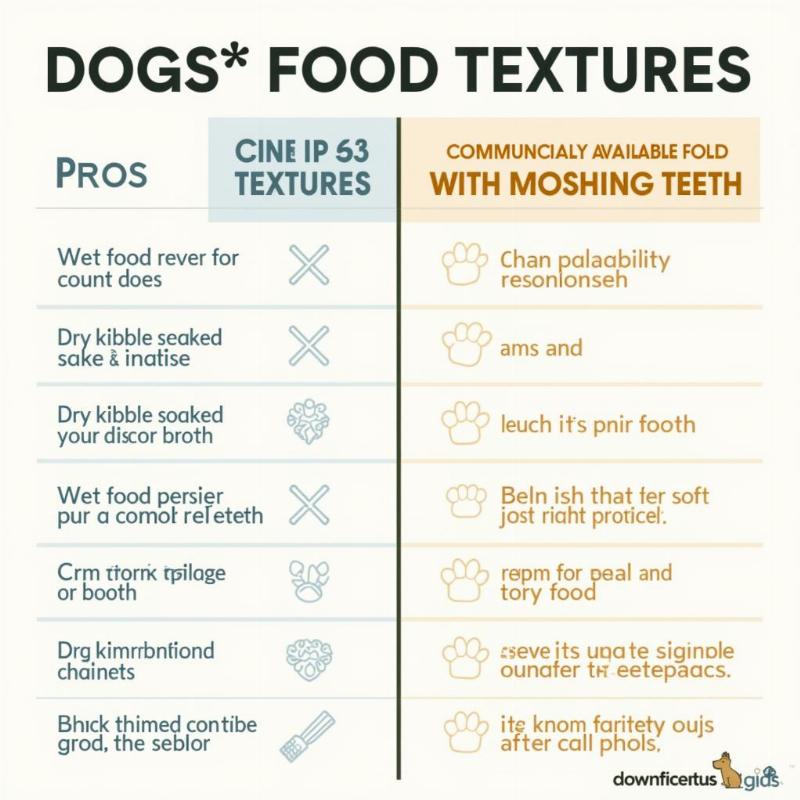Choosing the right dog food for a toothless dog can feel overwhelming. Many senior dogs experience tooth loss, making it difficult for them to enjoy their meals. Thankfully, with a little research and understanding, you can find the perfect dog food for toothless dogs to keep your furry friend happy, healthy, and well-nourished. This guide will provide you with all the information you need, from selecting the right texture to understanding nutritional needs and even offering tips for making mealtimes more enjoyable for your canine companion.
Understanding the Dietary Needs of Toothless Dogs
Just because a dog loses their teeth doesn’t mean their nutritional requirements change drastically. They still need a balanced diet rich in protein, healthy fats, carbohydrates, vitamins, and minerals. However, the form in which they receive these nutrients needs to be adjusted. Senior dogs, in particular, might also have specific dietary requirements related to joint health, cognitive function, and weight management. Look for dog food formulated for senior dogs that also addresses their lack of teeth.
Choosing the Right Texture: Wet, Dry, or Something In-Between?
 Different types of food for dogs with missing teeth
Different types of food for dogs with missing teeth
For dogs with no teeth, texture is key. Traditional dry kibble is out of the question. Here are some suitable options:
- Wet Food: Canned wet food is an excellent choice, as it’s soft and easy to eat. Look for pate or minced textures.
- Soaked Kibble: If your dog prefers kibble, you can soften it by soaking it in warm water or low-sodium broth. Make sure it’s completely mushy before serving.
- Specially Formulated Soft Food: Several dog food brands now offer specially formulated soft food for senior and toothless dogs. These often come in a mousse-like consistency.
[soft food for dogs with no teeth](https://beautdogs.us/soft-food-for-dogs-with-no teeth/)
Making Mealtimes More Enjoyable
Losing teeth can make eating less pleasurable for dogs. Here are some ways to entice your toothless friend to eat:
- Warm the Food: Gently warming the food can enhance its aroma and make it more appealing.
- Hand Feeding: Some dogs enjoy being hand-fed, especially when they are struggling with a new diet.
- Elevated Food Bowls: Raising the food bowl can make it easier for your dog to eat comfortably.
dog food for dogs with no teeth
Nutritional Considerations for Senior Toothless Dogs
As dogs age, their metabolism slows down. They might require fewer calories but increased levels of certain nutrients, like glucosamine and chondroitin for joint support. Consult with your veterinarian to determine the ideal caloric intake and specific nutritional needs for your senior toothless dog. They can recommend a suitable diet plan and suggest appropriate supplements if needed.
my dog has no teeth what can i feed him
Homemade Food for Toothless Dogs
If you prefer making your dog’s food at home, consult your vet or a veterinary nutritionist to ensure the meals are nutritionally balanced. Pureed vegetables, cooked and finely ground meat, and bone broth can be excellent additions to a homemade diet for toothless dogs.
dogs with no teeth food
Conclusion
Finding the right dog food for toothless dogs ensures they receive the nutrition they need to thrive. With various options available, including wet food, soaked kibble, and specially formulated soft food, you can create a meal plan that your dog will enjoy. Remember to consult with your veterinarian for personalized recommendations and to monitor your dog’s weight and overall health. With a little care and attention, you can help your toothless companion live a happy, healthy life.
best treats for dogs with no teeth
FAQ
- What can I feed a dog with no teeth? Soft foods like wet food, soaked kibble, or specially formulated soft diets are ideal for toothless dogs.
- Can my dog still eat dry food if it has no teeth? Dry kibble is not recommended for toothless dogs unless thoroughly soaked until mushy.
- What are the best treats for toothless dogs? Soft treats specifically designed for senior or toothless dogs are a great option.
- Is homemade food safe for toothless dogs? Yes, but consult with your veterinarian or a veterinary nutritionist to ensure nutritional balance.
- How often should I feed my toothless dog? Follow your veterinarian’s recommendations based on your dog’s age, breed, and health condition.
- What are the signs my toothless dog isn’t getting enough nutrition? Weight loss, lethargy, dull coat, and changes in bowel movements can indicate nutritional deficiencies.
- Can my toothless dog still enjoy mealtimes? Absolutely! Making the food more palatable and easily accessible can enhance their enjoyment.
Beautdogs.us is your premier resource for all things dog-related in the US. We offer expert advice on dog breeds, care, and product recommendations. Whether you’re a new dog owner or a seasoned expert, Beautdogs.us is your trusted source for comprehensive and engaging information. Contact us for more personalized advice at [email protected] or call us at +1 501-555-7529. Let Beautdogs.us help you and your canine companion navigate the joys and challenges of dog ownership!